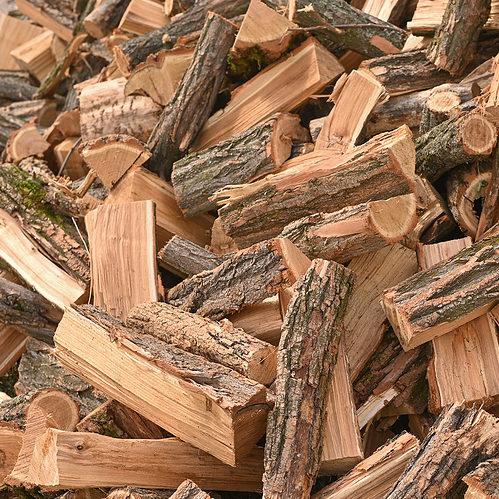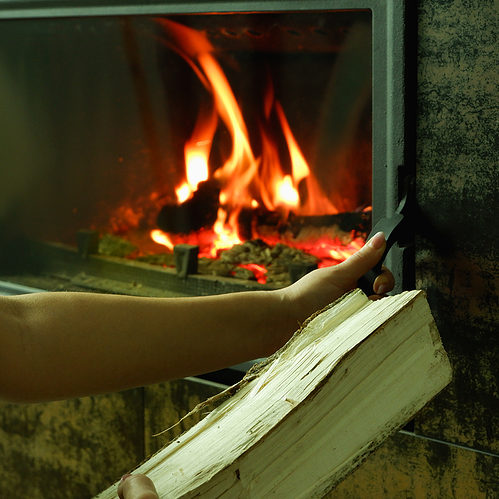Now, you might be thinking, “How does one not know how to start a fire in their fireplace?” Well, it may seem easy to start a fire, but it’s a challenge to build it and light it, so it burns efficiently and doesn’t constantly need relighting. It turns out there’s a proper way to start a fire, and in this post, we’ll show you how to do it.
 Remove the Ashes
Remove the Ashes
The first step to building a roaring fire is to clean out any leftover ashes from the firebox from your previous fire to make it easier to stack your wood. To clean out the ash, remove any large chunks with a broom and shovel, then vacuum the smaller debris. Also ensure you have had your annual chimney sweeping and inspection!
Use the Right Firewood
Many people don’t realize that the kind of wood you use affects how hot and efficient your fire burns, but choosing the proper firewood is essential to building a healthy fire.
If you’re using a wood-burning fireplace, the best wood is seasoned firewood. Seasoned firewood is wood thoroughly dried for approximately six months to a year. Seasoned firewood is the ideal choice for several reasons:
- It’s easier to light
- It produces less smoke, which means less creosote buildup
- It burns more evenly and thoroughly
- It gives you a hotter fire
Seasoned firewood indeed costs more upfront, but because it burns longer, you end up using less, which can save you money through the fireplace season. Some fireplace experts also recommend kiln-dried firewood, which is also a good choice if you don’t have time to dry firewood the traditional way.
Check Your Fireplace’s Damper
The fireplace or chimney damper is a metal device that opens and closes to regulate airflow through the chimney. When open, the damper allows smoke and toxic gases to flow from the fireplace up the chimney and out of the house. When it’s closed, it prevents outside air from getting into the house. If your damper won’t completely open or close, your fire won’t receive enough oxygen, causing it to burn inefficiently.
Furthermore, if the damper won’t fully open, you could end up with more smoke and harmful fumes in your home, so before you build a fire, check the damper and ensure it’s in good working order.
Prime Your Flue
Another step many forget or don’t know about is priming the flue. If you’ve seen smoke fill your room soon after lighting a fire, it means the ignition wasn’t complete —either the fire didn’t get enough energy or oxygen to achieve good combustion. When your fireplace and chimney sit idle during cold weather, the flue becomes filled with cold air. So, because cold air is heavier than hot air when you first light your fire, the smoke can’t escape up the chimney. To prime the flue, roll up a few newspapers or other materials for a makeshift torch, light one end, and hold it up the flue until you see the smoke traveling up. When the smoke goes up the chimney, you know you’re good to go to light your fire.

Add Kindling
Yes, you can start a fire without kindling, but we’re telling you how to build the best fire, so this is a must. Kindling is dry wood, typically cut in thin strips about a foot long. The reason kindling is a must is because of how easily it catches fire and holds the flame long enough to ignite the logs on top. Like your logs, it’s best to use seasoned wood for your kindling.
Build Your Log Base
Many people chuck the logs into the firebox and hope for the best. However, there’s an art to stacking your logs to get the most efficient and hot burning fire you crave. To start, put big logs on the bottom, keeping them as close together as possible.
Next, start stacking your smaller logs on top. Continue building like this until you have enough to keep you warm.
Start Your Fire
Now that you’ve done the work, it’s time to start your fire, kick back, and relax. While this may seem like a lot of steps, it doesn’t take much time, and you’ll be thankful that you put in the effort when you see and hear that beautiful roaring fire.
If you have questions about building fires or need expert chimney sweeping, repairs, or maintenance, call us at 913-236-7141. We’re certified by the Chimney Safety Institute of America and the National Fireplace Institute.



